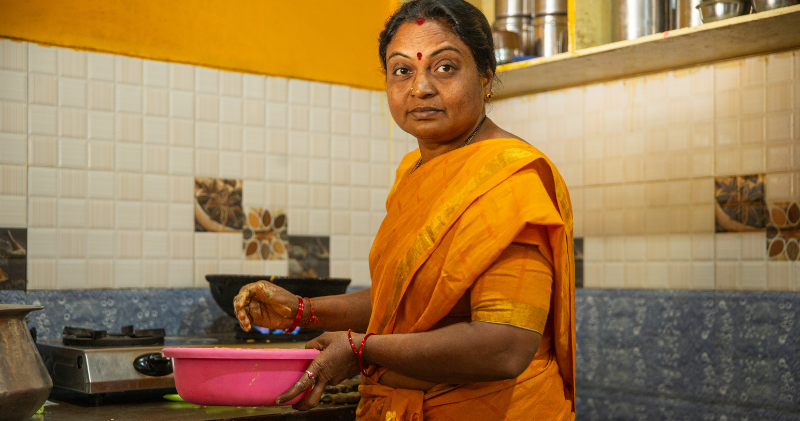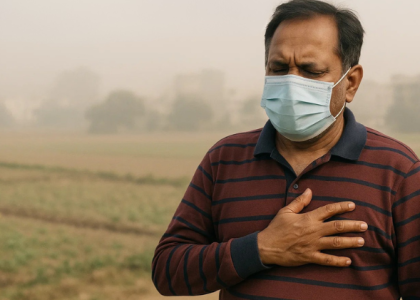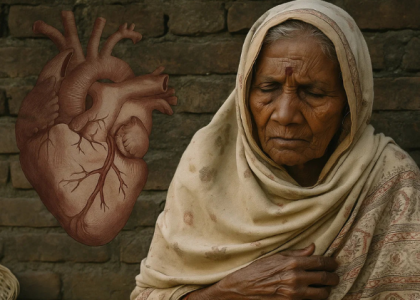Indoor Air Pollution: A Hidden Heart Risk in South Asian Homes
Many people think indoor air is safe — especially if they don’t smoke inside. But in reality, indoor air pollution is a silent heart risk affecting millions of South Asian homes. The very activities that make our houses feel like homes — cooking traditional meals, burning incense during prayer, or using mosquito coils to protect our families — might actually be putting our hearts at risk.
A Surprising Heart Risk in Our Own Kitchens
When Lakshmi visited her doctor for chest pain, she was confused by his questions about her cooking habits. “I’ve never smoked a cigarette in my life,” she told him. “Why are you asking about smoke?” Her doctor explained that the hours she spent daily cooking in her poorly ventilated kitchen were exposing her lungs to harmful particles — and her heart was suffering as a result.
The World Heart Federation reports some eye-opening facts:
- 3 billion people worldwide cook with polluting fuels like wood or kerosene
- Indoor air pollution can be 100 times higher than safe levels
- 3.8 million people die yearly from illness related to indoor air pollution
- 45% of those deaths are from heart disease or stroke
How Cooking Smoke Affects Your Heart
When we cook with high heat, especially frying or tempering spices (tadka), or when we burn wood, kerosene, or incense, tiny particles are released into the air. These particles are so small you can’t see most of them, but they can cause serious damage:
- They enter your bloodstream: These tiny particles travel from your lungs into your blood
- They trigger inflammation: Your body reacts by creating inflammation throughout your system
- They raise blood pressure: Regular exposure can cause your blood pressure to stay elevated
- They can trigger blood clots: These particles make your blood more likely to form dangerous clots
For people who already have risk factors like diabetes, high blood pressure, or a family history of heart problems, indoor air pollution can be the extra burden that leads to a heart attack or stroke.
Why South Asian Homes Have Higher Risk
Kitchen Design and Cooking Practices
- Many traditional kitchens lack proper ventilation or exhaust fans
- Cooking multiple meals daily means longer exposure to cooking smoke
- High-heat cooking methods like deep frying or tadka create more particles
- Multi-generational homes mean more cooking and more people exposed
Cultural Practices
- Regular use of incense during prayer rituals
- Mosquito coils or dhoop used in bedrooms at night
- Traditional fuel use (wood, cow dung, or kerosene) in some areas
- Indoor celebrations with diyas or candles in closed spaces
Sarla, who lives in a two-bedroom apartment in New Jersey with her husband, son’s family, and elderly mother, noticed everyone seemed to have more coughing and headaches during winter when windows stayed closed. After installing a kitchen exhaust fan and air purifier, these symptoms improved—and her mother’s blood pressure became easier to control.
Simple Changes That Protect Your Heart
The good news is that you don’t need to abandon cultural traditions to protect your heart. These practical steps can dramatically reduce your exposure:
Improve Kitchen Ventilation
- Open windows when cooking, especially during tadka or frying
- Install an exhaust fan that vents to the outside (not just a filter)
- Use lids on pots to reduce smoke and save fuel
- Cook in larger batches when possible to reduce total cooking time
Consider Alternative Cooking Methods
- Use pressure cookers to reduce cooking time
- Try induction cooktops instead of open flame when possible
- Experiment with air fryers for foods usually deep-fried
- Pre-soak beans and lentils to reduce cooking duration
Adjust Other Indoor Practices
- Burn incense near open windows or in well-ventilated areas
- Consider electric options instead of mosquito coils
- If using diyas or candles, place them where air flows
- Encourage family members in India to consider switching from wood/kerosene to LPG or electric cooking
For Those Who Can’t Change Fuels
- Create a separate, well-ventilated cooking space if possible
- Keep children away from cooking areas
- Cook outdoors when weather permits
- Reduce cooking time through food preparation techniques
Protecting Those We Love
Making these changes isn’t just about your own health—it’s about protecting everyone who shares your home. Children, elderly parents, and those with existing heart conditions benefit most from cleaner indoor air.
Remember: awareness, not guilt, is the goal. Many of us didn’t know about these risks before, but now we can make simple changes that honor our cultural traditions while protecting our hearts.
Take Action Today
If you have family members in India or other South Asian countries who still cook with wood or kerosene indoors, share this information with them. A simple conversation could save lives.
Consider these steps today:
- Open a window the next time you cook
- Talk to family members about kitchen ventilation
- Share this article with friends who might benefit
Our cultural traditions bring richness to our lives. With small adjustments, we can preserve these traditions while ensuring our homes remain the safe, healthy havens they’re meant to be.




